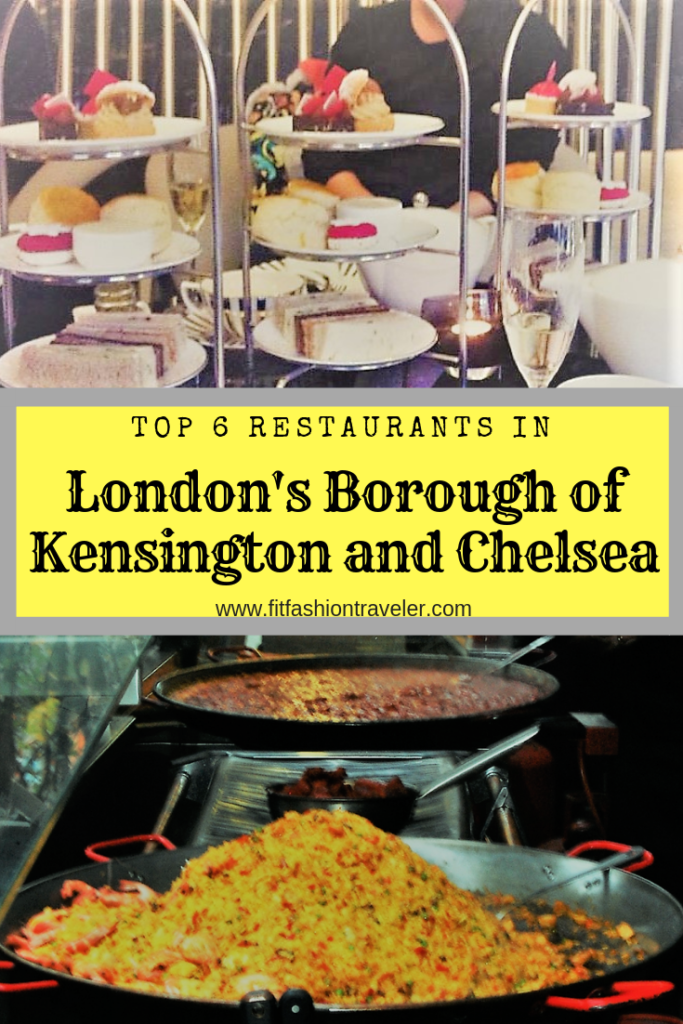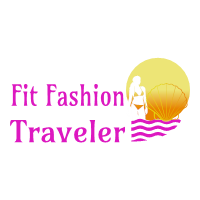
by Kelly | Mar 10, 2019 | Europe, Travel, Travel Advice
BREAKING NEWS: you will soon need a visa to visit Europe!
Actually, despite all the recent news headlines, this is not quite true.
The truth is the European Union ("EU") is creating a new travel authorization security system for travelers arriving from its sixty visa-waiver countries. The system will be implemented in 2021. It will require proof of pre-approved travel authorization. Though this system is not a new visa, it means there are some immigration changes you'll want to know about.
N.B. While part of this post addresses legal requirements, nothing written here should be construed as legal advice. The information in this post is accurate at the time of publication. For the most up-to-date information, please see the government websites at the bottom of this post.
Current Status of European Travel for Americans
Visa Waiver Program for Americans
The US has agreed to Visa Waiver Programs ("VWPs") with 25 of the 26 Schengen Area member states, with Poland being the exception. It also has a VWP with the UK, Ireland, Andorra, Monaco, and San Marino. This means that citizens of these European countries can enter the US visa-free. American citizens may do the same when arriving in any of these countries.
For more information on VWPs, see the "What is a Visa?" section below.
Travel within the Schengen Area
One of the major commitments of the EU is the free movement of people. The current system almost reflects this ideal. Instead of the free movement within the EU, there is free movement within the Schengen Area. The EU consists of 28 (soon to be 27) European member states, while the Schengen Area has 26 slightly different member states. Norway, Iceland, Liechtenstein, and Switzerland are not EU members but they are Schengen Area members.
The 26 Schengen Area member states are Austria, Belgium, Czech Republic, Denmark, Estonia, Finland, France, Germany, Greece, Hungary, Iceland, Italy, Latvia, Liechtenstein, Lithuania, Luxembourg, Malta, Netherlands, Norway, Poland, Portugal, Slovakia, Slovenia, Spain, Sweden, and Switzerland. If you are an American citizen entering Europe through any of these countries you do not need a visa.
Once a traveler arrives in a Schengen country, he or she may travel between the other Schengen countries for up to 90 days without encountering immigration authorities. This is true for both visa-free travelers and travelers with a formal, pre-approved Schengen visa. It is comparable to when a foreign visitor enters the US at New York's Laguardia airport and goes through immigration there but then takes a road trip through Pennsylvania, Ohio, and Illinois to reach Chicago without encountering any additional immigration stops.
This visa-free travel situation and free movement within the Schengen Area will not change with the new EU travel authorization system.
European Travel Information and Authorization System
On September 14, 2016, European Commission President Jean-Claude Juncker delivered a speech advocating for an increased European security system. He said "We need to know who is crossing in our borders. This way we will know who is travelling to Europe before they even get here". Two months later, the European Commission proposed a new travel authorization system called the European Travel Information and Authorization System ("ETIAS").
Origin of ETIAS
On July 5, 2018, the European Parliament adopted ETIAS in agreement with the European Commission. The adopted law permits the establishment of the ETIAS under the purview of the newly-strengthened eu-LISA security agency. The Parliament has tasked eu-LISA with making ETIAS operational by the end of 2021. Many news outlets are reporting that the system will be in place by January 1, 2021.
What is ETIAS?
The European Commission is emphatic that "the ETIAS authorization is not a visa." After many false news reports this past week about a new EU visa, the EU Ambassador to the US, Stavros Lambrinidis, posted on Twitter that "[n]either the #ESTA nor the future #ETIAS (EU equivalent) are visas. They carry out pre-travel screening for travellers benefiting from visa-free access."
ETIAS is a pre-travel authorization program designed to reduce immigration procedures and wait times, as well as help improve the security of the EU. It pre-screens travelers for security, health, and migration risks. The system will allow the EU to keep track of visitors from countries that otherwise do not need a visa to enter the Schengen Area. The European Commission believes the system will be affordable, simple, and fast. It will allow cross-checking of EU information systems and provide clear rules for refusals with an appeals process.
Potential travelers will have to submit a short online application and pay an application fee of 7 euros. The EU estimates that 95% of applicants will receive an approval by email within minutes of submitting the application. Once a traveler receives an ETIAS travel approval, they can travel freely to and from the Schengen Area using that approval for up to three years. The approval is connected to your passport, so if your passport expires before the three-year authorization expires you will have to re-apply.
What this Means for Americans, Brits, Australians, and Other Visa-Free Country Travelers
The ETIAS travel authorization will be required for visa-free travelers, which will likely include UK citizens post-Brexit. Travelers that are entering Europe visa-free for tourism, business, or just in transit to another region will need an ETIAS authorization. This means if you have a flight from New York to Dubai with a connection in Frankfurt, you will need an ETIAS authorization even if you never intend to leave the Frankfurt airport.
If you are coming from a country that requires a formal Schengen visa, you will not need to apply for an ETIAS travel authorization. If you are a dual citizen with citizenship in a Schengen Area country, you will not need ETIAS authorization if you enter Europe using your European passport.
Using your ETIAS Authorization
When the ETIAS system enters into effect, travelers will need to receive authorization prior to arriving in Europe. When you first use your authorization, you will have to enter the Schengen Area through the country you indicate in your application. If you enter through a different Schengen country the authorization will be invalid and you will be denied entry. Note that most travelers pass through European immigration at their port of arrival. For example, a traveler flying from Boston to Rome with a connection in Madrid usually enters Europe in Spain, not Italy. After your initial use of the authorization, you may enter through any Schengen country you would like using your valid authorization.
N.B. the ETIAS authorization will not be required for travel to UK, Ireland, Romania, Bulgaria, or the former Yugoslav countries (except Slovenia) until they join the Schengen Area.
After receiving your authorization and using it to enter the Schengen Area for the first time, travel to and from the EU will be no different than it is today until your authorization or passport expires, at which time you will need to reapply. This means ETIAS will be a slight inconvenience for those of us traveling from visa-free countries the first time we go to Europe, but otherwise will not change our travels very much.
How to Apply for an ETIAS Authorization
Once the system goes live, citizens of visa-free travel countries will be able to apply online. The application will include questions about basic biographical information, such as your full name, country of residence, date of birth, and similar information about your parents. It will also ask questions related to health, security, and migration, such as drug use, terrorism links, travel to conflict areas, past EU travel, criminal history, and employment history. No biometric data like finger prints will be required, though it will be beneficial to apply with a biometric passport.
After completing the online application form you will provide an email address and pay by credit or debit card. When payment is received, your information will automatically be cross-checked against security databases including Interpol and Eurpol. If there are no "hits," you should receive your authorization by email within minutes of applying.
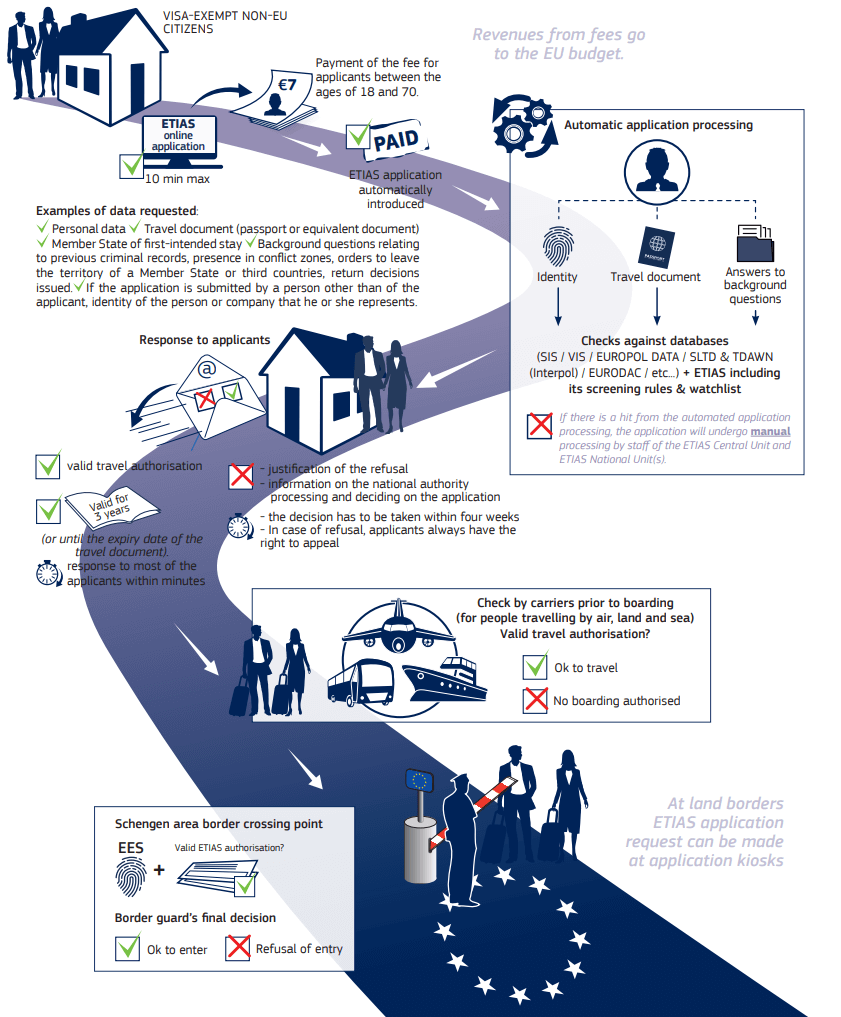
ETIAS Application Process; graphic source: https://www.schengenvisainfo.com/etias/
How Far in Advance Should You Apply
Though most applications are expected to be approved within minutes, the length of the refusal process means you should apply at least five weeks before your travel will take place. Carriers will not allow a passenger to board their transportation to Europe without proof of authorization. Even if you are certain you will receive travel authorization mistakes and false hits can happen. You may need the full five weeks to clear up any issues and receive valid authorization.
What to do If You're Refused an Authorization
If your information produces a hit on one of the information security databases, you will receive an email stating your application has been refused. At this point, your application will be manually reviewed by ETIAS staff and additional documentation may be requested. You will have 96 hours to provide the requested documentation. The national authority of the Schengen Area country to which you apply then has four weeks to make a decision on your authorization. The European Commission assures travelers that an appeals process will be available for individuals who are refused authorization after the manual review.
How ETIAS Authorization is Different from a Visa
The EU has made it clear that an ETIAS authorization is not a visa. It is the European equivalent to the current ESTA authorization required by the US for travelers taking advantage of a Visa Waiver Program. ETIAS authorizations will facilitate immigration procedures upon arrival in Europe because the cross-checking of individuals against international security databases will have been done ahead of time.
What is a Visa?
A visa is "an endorsement issued by an authorized representative of a country and marked in a passport, permitting the passport holder to enter, travel through, or reside in that country for a specified amount of time for the purpose of tourism, education, employment, etc". Visas may be granted before travel, with a permanent visa stuck to a page in your passport. Others are received upon arrival at a country's border. Some countries have implemented Visa Waiver Programs ("VWPs"). Regardless of the type of visa, foreign travelers must be pre-approved for travel by through one of these three methods.
Formal Pre-Approved Visa
When you think of a visa, you probably think of the fancy certificate stuck to a page in your passport. Maybe you received one when you studied abroad in college. Perhaps you are one of the fortunate travelers to have a ten-year, multi-entry tourism visa for China. You may have opted to obtain a pre-approved visa before traveling to a country like Vietnam.
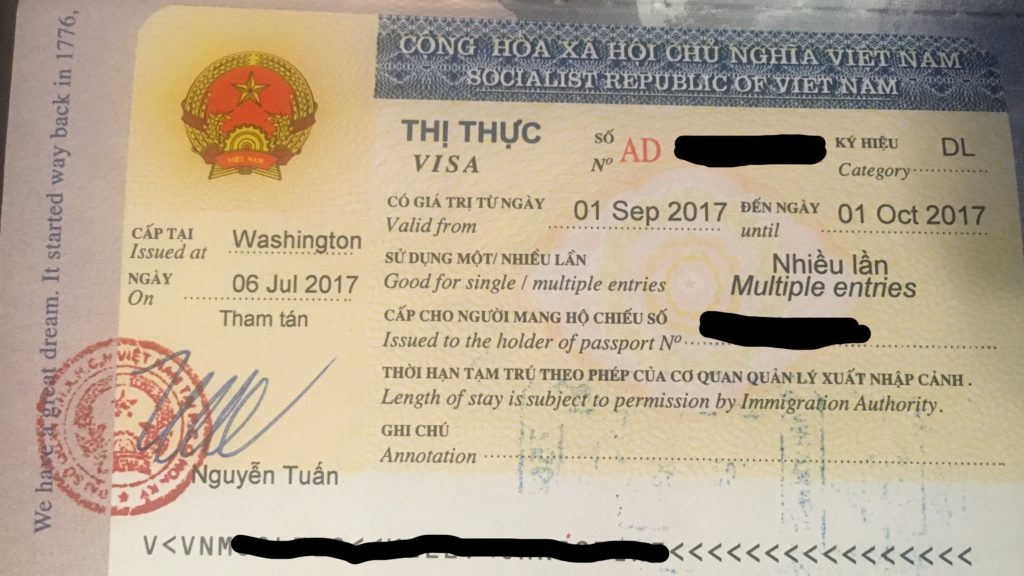
Pre-approved visas require a lengthy and costly application process. Applicants fill out a multi-page application with biographical, financial, and travel information. The applicant then sends a paper copy of the application to the relevant consulate along with passport photos, his or her passport, and the application fee. Application fees range from $20 USD to hundreds of dollars depending on the country and type of visa requested. Sometimes applicants have to appear in-person at the consulate to receive the visa and collect their passport. If you live in a major city this may only require a few hours off work. Alternatively, imagine living in Alaska and having to appear in person at a consulate in San Francisco!
Formal, pre-approved visas are the most difficult to obtain. They are usually required in reciprocity. If the US requires citizens of a country to obtain a formal visa before visiting, US citizens will have to receive a formal visa before traveling to that country as well.
Visa on Arrival
You may have previously received a visa on arrival and not even known it! Visas on arrival look similar to entry stamps received under VWPs. The difference is visa-on-arrival stamps lay out the visa requirements and restrictions for the traveler in the stamp. The stamps are often accompanied by payment of an entry or exit fee. You must also fill out a paper with your travel details and provide it to immigration officials upon arrival. This paper is cross-checked with another similar paper turned over when you leave the country.
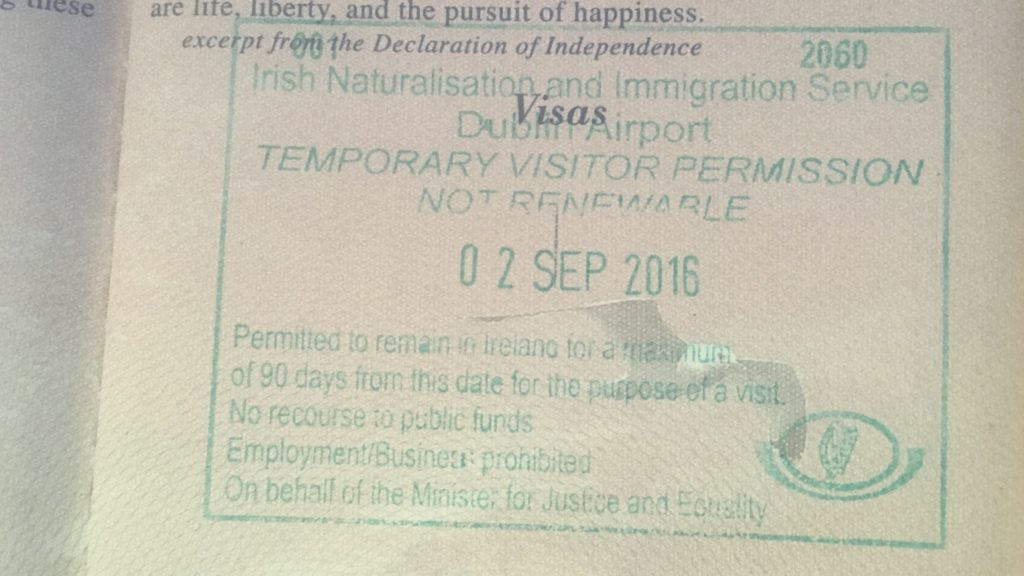
Example of visa requirements included in a visa stamp
Countries implementing visa on arrival programs do not have bilateral treaties with your country of citizenship to provide visa-free travel. They have nevertheless decided not to require the process of applying for a visa before traveling to their country.
Visa Waiver Programs
Visa Waiver Programs ("VWPs") allow citizens of participating countries to enjoy visa-free travel to other participating countries. VWPs are established with bilateral treaties allowing reciprocal treatment for citizens of each country involved. There are thirty-eight countries currently participating in the US VWP, including most EU and Schengen Area member states.
Traveling to a VWP country requires nothing beyond speaking with an immigration officer upon arrival. By virtue of being a citizen of a participating country, you may enter another participant country without a visa as a tourist or business person. If you plan to study or work in a foreign country then you will probably need to apply for a visa.
When you arrive at a visa-free country, you will likely receive a stamp in your passport showing port of entry into the country. This stamp is not a visa. It is proof that you entered the country legally. Most immigration authorities will check for this stamp when you leave the country.
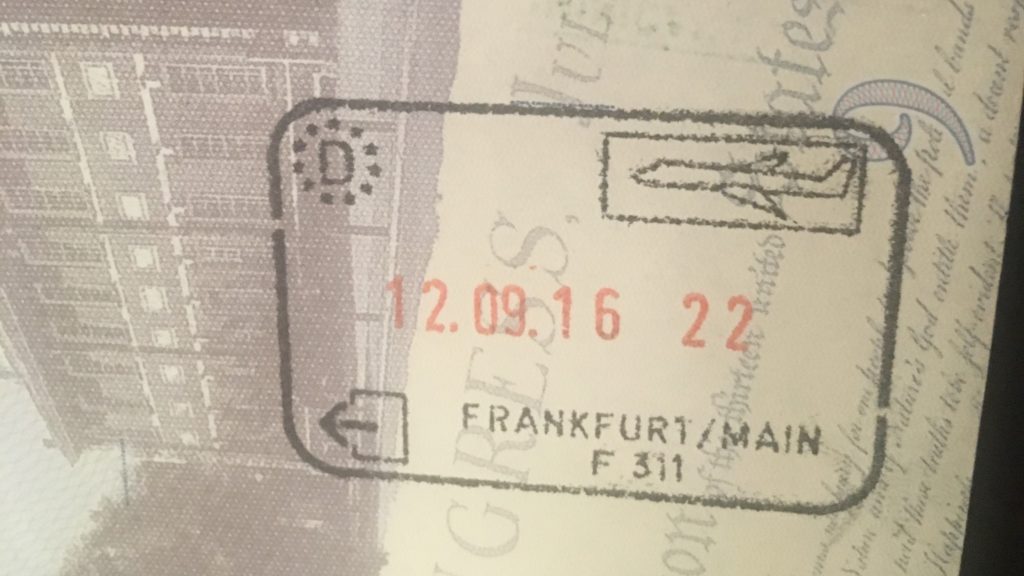
Port of Entry/Exit Stamp
The ETIAS Difference
ETIAS does not provide automatic immigration authorization as a visa does. It also does not lay out requirements and restrictions for travelers to follow as visas do. It is merely a first-step authorization for traveling to or through Europe. Visitors with a valid authorization may still be denied entry by immigration officials for other immigration-related reasons. ETIAS authorization merely proves to carriers like airlines and to European immigration officials that you do not pose a security, health, or migration threat to Europe. This is only the first step in being allowed to enter Europe, which is currently done when you arrive at the border. Starting in 2021, this check will be completed ahead of time. I'm hopeful this will mean shorter immigration lines at European airports once the program is in place!
For more information, see the following websites used to write this article:
http://europa.eu/rapid/press-release_IP-18-4367_en.htm
https://www.schengenvisainfo.com/etias/
https://www.cbp.gov/travel/international-visitors/visa-waiver-program
https://www.etiasvisa.com
12 March 2019: This post has been updated for clarity, and to add information about travelers transiting through Europe.
Love this post? Save it to Pinterest for Later!

by Kelly | Oct 8, 2018 | Connecticut, Day Trips, Itineraries, North America, Travel, United States
For many people, Fall is one of the best times to visit and explore New England. Many people head north to Vermont or New Hampshire for leaf-peeping. If you are looking for something off-the-beaten-path this year, check out these great activities in Central Connecticut!
Looking for more Fall New England activities? Check out this post about a Fall Weekend in New Hampshire, and this one about what to do in Salem, Massachusetts!
Apple and Pumpkin Picking
Apple and pumpkin picking are two can’t-miss activities in central Connecticut. The season for apples begins around the end of August and continues through the beginning of October. Pumpkin season runs from the end of September through October. Check out either of the orchards below for your farm-fresh apple and pumpkin needs.

Lyman Orchards
Many people visit Lyman Orchards every year for its apples and pumpkins, as well as it’s annual corn maze. Many other people visit just to purchase one of their well-known pies. If you have trouble deciding, go for the Hi-Top Apple Pie, which is perfect when served at Thanksgiving dinner.
32 Reeds Gap Road, Middlefield, CT 06455 * https://www.lymanorchards.com/
Dondero Orchards
Growing up in central Connecticut, Dondero Orchards offered a no-frills fall experience for cheap apple and pumpkin picking. Over the years, its popularity has allowed it to grow into one of the most popular farms in the area. Pumpkins are no longer 10 cents per pound, but instead there are craft fairs, a farmers market, farm stand, and farm-to-table dinners offered by the orchard.
529 Woodland Street, South Glastonbury, CT 06073 * https://www.donderoorchards.com/
Apple Festivals
What do Nutmeggers do after they’ve picked all their apples? We host apple festivals, of course! The two most popular festivals are held annually in Southington and Glastonbury.
Southington Apple Harvest Festival
Grab a fresh apple fritter and listen to the live music provided by the Southington Apple Harvest Festival! Complete with carnival rides, a craft fair, a pie baking contest, fireworks, and a parade this festival embodies central Connecticut in the Fall. You can always expect to see great musical acts: this year’s entertainment was opened by Bowling for Soup! Held the last weekend of September and the first weekend of October, you’ll have to mark this one on your calendar for next year.
75 Main Street, Southington, CT 06489 * 2019 Dates: 9/27-9/29, 10/4-10/6 * http://www.southingtonahf.com/
Glastonbury Apple Festival
The Connecticut River Valley Chamber of Commerce hosts its annual apple festival in Glastonbury every year. As stated on its website, “For the 5th year consecutive year, the Apple Harvest Festival will feature three stages of live music with 30 emerging artists, a full midway of amusement rides, over 100 vendors, 25 food trucks/purveyors, the extremely popular Harvest Pub, the Angry Orchard 5K Road Race and all things fall in New England.” This festival will take place next weekend, so if you want to get the full Fall experience in Connecticut, hop in your car and drive down to Glastonbury for a day!
300 Welles Street, Glastonbury, CT 06033 * 2018 Dates: 10/12-10/14 * https://www.crvchamber.org/events/details/44th-apple-harvest-festival-10-12-2018-5134
Town Fairs
If you prefer fairs that have less of a focus on apples and more on animals, add the following agricultural fairs to your calendar. Although they have both ended for 2018, they are worthwhile to make note of for Fall 2019!

Durham Fair
The Durham Fair is considered Connecticut’s largest agricultural fair. For just four days, you can visit the fair to see prize-winning animals, enjoy fresh or fried fair food, ride the rides at Midway, and see performing acts like Melissa Etheridge and Scott Mccreery, the two 2018 headliners. If the famous Topsfield Fair in Massachusetts is not an option for you, check out the Durham Fair instead for a comparable experience.
24 Town House Road, Durham, CT 06422 * 2019 dates: 9/26-9/29 * https://www.durhamfair.com
Haddam Neck Fair
For a smaller agricultural fair in central Connecticut, spend your Labor Day Weekend at the Haddam Neck Fair. Started by the Haddam Neck Grange in 1910, the fair now spans three days and welcome tens of thousands of guests. It no longer just shows off animals and vegetables, but instead provides carnival rides, a variety of food, Country Western entertainment, a legendary tractor pull, and a recently-added 5K road race. If you want to experience a typical Connecticut agricultural fair without the crowds attracted to Durham, the Haddam Neck Fair is perfect for you.
207 Middle Haddam Road, Middle Haddam, CT 06456 * 2019 dates: 8/30-9/2 * http://haddamneckfair.com
Vineyards and Breweries
Chateau Le Gari
Connecticut has over 35 vineyards and wineries to explore: impressive for a state where little is known about its wine. One of my favorites is Chateau Le Gari. This vineyard was founded last year by the former Vice President of the CT Farm Wine Development Council, Gary Crump. The property is beautiful and the wines are flavorful, with most of the grapes grown right on the property.
One of the best parts about this vineyard is the presence of Gary himself. When you arrive for a tasting you may be greeted by the former-Cajun behind the tasting bar pouring his own wine and telling you stories from his career and life. If you are lucky, you may even get to try some of his local cooking. Every Sunday afternoon, Gary makes and serves pasta with bolognese to his guests! Gary’s knowledge of wine is astounding, so if you can catch him while you’re here for a conversation, be sure to do so.
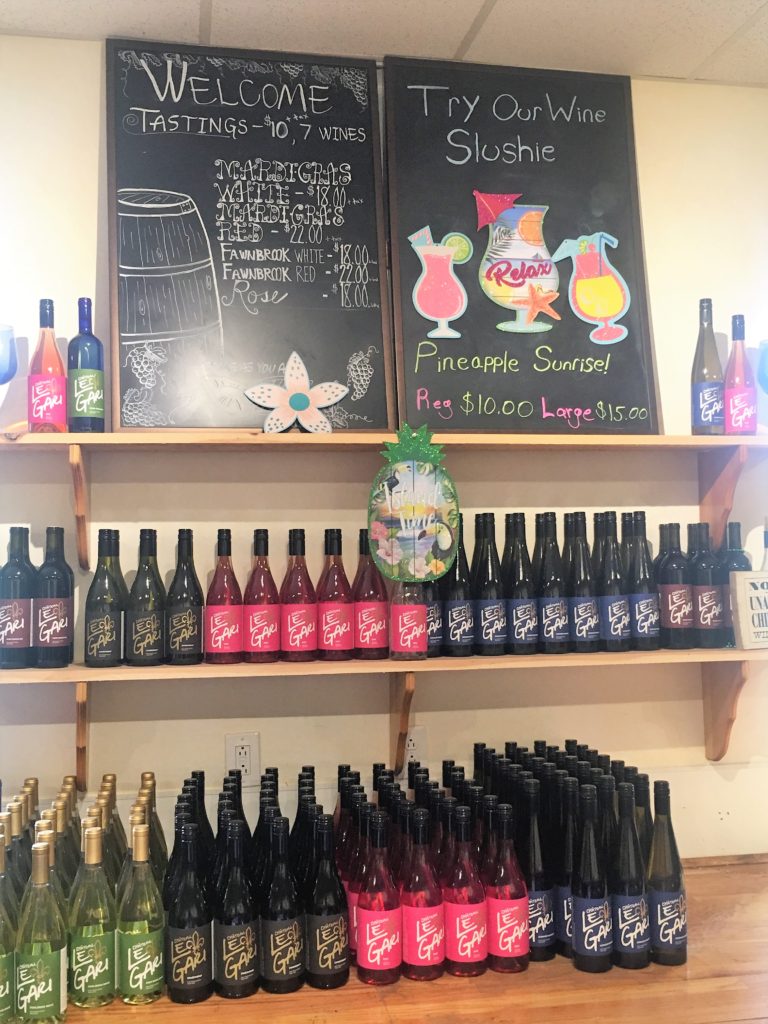
303 South Main Street, Marlborough, CT 06447 * https://www.chateaulegari.com
Priam Vineyards
Priam Vineyards is located less than five minutes from Chateau Le Gari. In fact, Priam was also founded by Gary Crump! Stop in for a quick tasting, or bring a picnic lunch to enjoy on the back patio with a bottle of local wine.
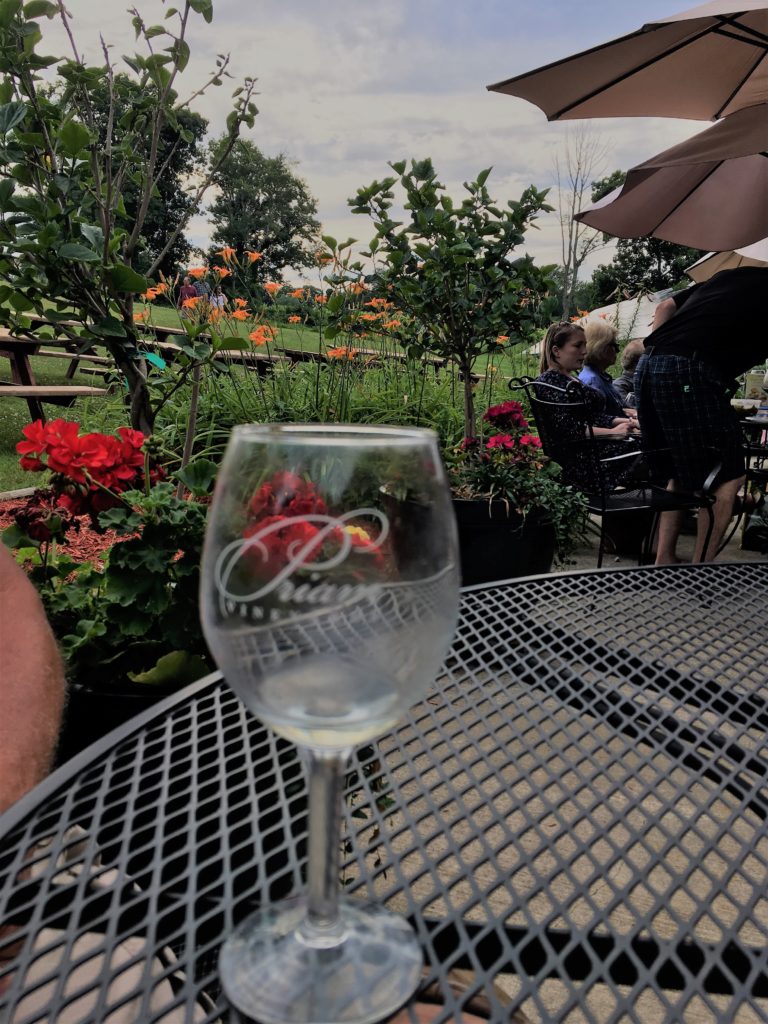
11 Shailor Hill Road, Colchester, CT 06415 * http://www.priamvineyards.com
Fat Orange Cat Brewery
A few years ago, Mike Klucznik started brewing his own beer for personal consumption, as many Americans do. After winning a number of home brewing competitions, he decided to open his own brewery. Sheila Mullen had ample space on her property in rural Connecticut, so the two built a barn to host the brewing operations and a small bar. The pair still travels with their team to national craft beer competitions, but if you like beer and are in the area, you should travel to the Fat Orange Cat Brewery to try the beer for yourself!

47 Tartia Road, East Hampton, CT 06424 * https://fatorangecatbrewco.com/
Pumpkintown, U.S.A.
If you only do one Fall activity in central Connecticut, you must visit Pumpkintown, U.S.A. In 1990, Sandra Peszynski of Paul’s & Sandy’s Too farm store painted faces on a few pumpkins, added some clothes, and invited the local townspeople to take photos. She had no idea that 28 years later, Pumpkintown would be the top non-scary Halloween attraction in Connecticut! The town now has a Saloon, Bank, Post Office (to mail your Pumpkintown postcards), Firehouse with a firepole to slide down, tires for jumping, a hay bale maze, tractor rides, and so much more! Don’t forget to take pictures!


93 East High Street, East Hampton, CT 06424 * http://www.pumpkintown.com
Old Airline Trail
Fall is the perfect season for hiking! While you won’t find many tall mountains in Connecticut, there are many beautiful trails to walk, run, or bike along. The Old Airline Trail stretches about 25 miles from East Hampton to Thompson. Built in 1873 to connect New York City and Boston, the tracks have long been covered by gravel to provide a recreational area to locals. Ample parking is available every few miles along the trail, and access is free.
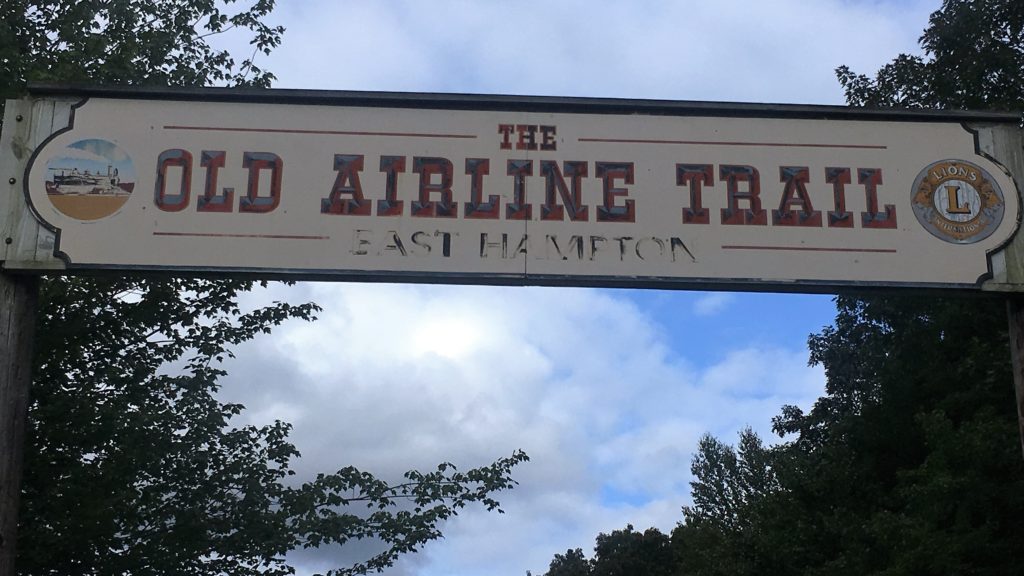
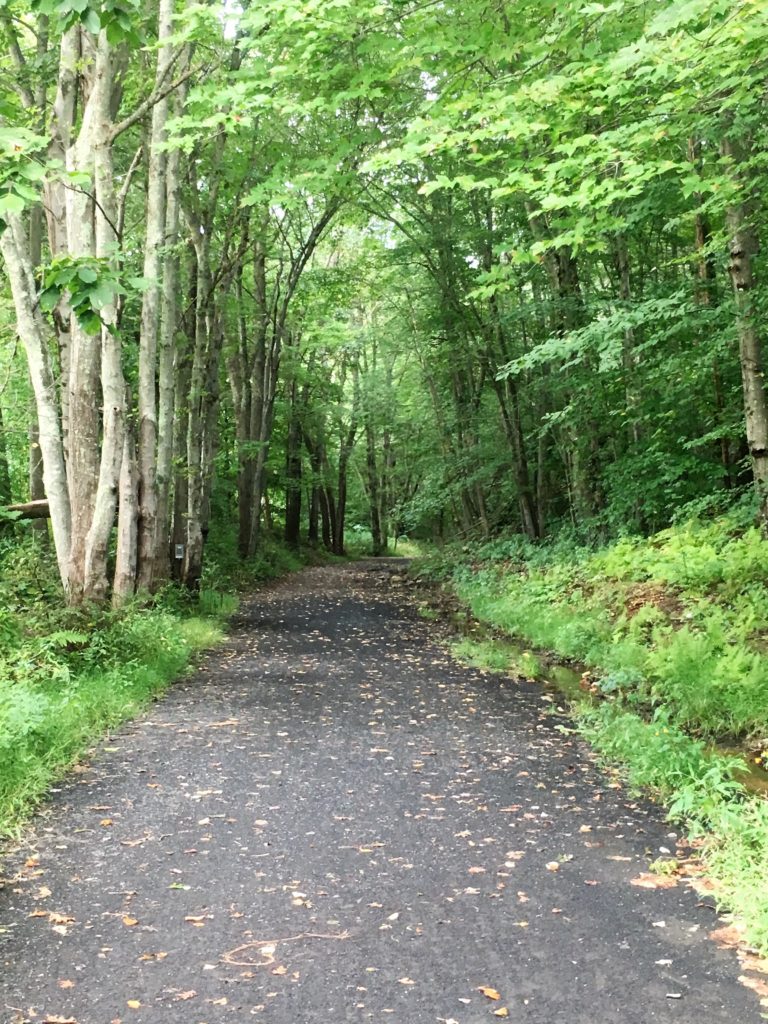
Trail head: 69 Smith Street, East Hampton, CT 06424 * https://www.ct.gov/deep/cwp/view.asp?a=2716&q=479336&deepNav_GID=1650
Lady Katherine Cruise
Central Connecticut is often referred to as the Connecticut River Valley due to the Connecticut River running through it. One of the best ways to experience the river is by taking a cruise. The Lady Katherine departs from Middletown and East Haddam, and offers Fall brunch and dinner cruises so you can enjoy the foliage on the water. If you are more of a Halloween person, check out the Halloween Murder Mystery Dinner Cruise!

Multiple Locations * http://ladykatecruises.com
Where to Eat in Central Connecticut
When you’re ready to take a break from all of the activities and grab some food, check out the places below! Central Connecticut has many amazing restaurants, but the three described here are especially fun in the Fall.
Goats N Roses
Goats and Roses provides one of the most authentic farm-to-table experiences in New England. As you pull into the parking lot on the farm, you are greeted by a farmhouse, tavern, general store, and goat yard. Grab a table – outdoor seating only – and pick one of your favorite farm dishes to eat. I recommend the Teriyaki Chicken Salad or Figgy Piggy Sandwich. After your meal, you can explore the property where you are likely to encounter some of the resident animals, like the chickens, peacocks, and of course goats!

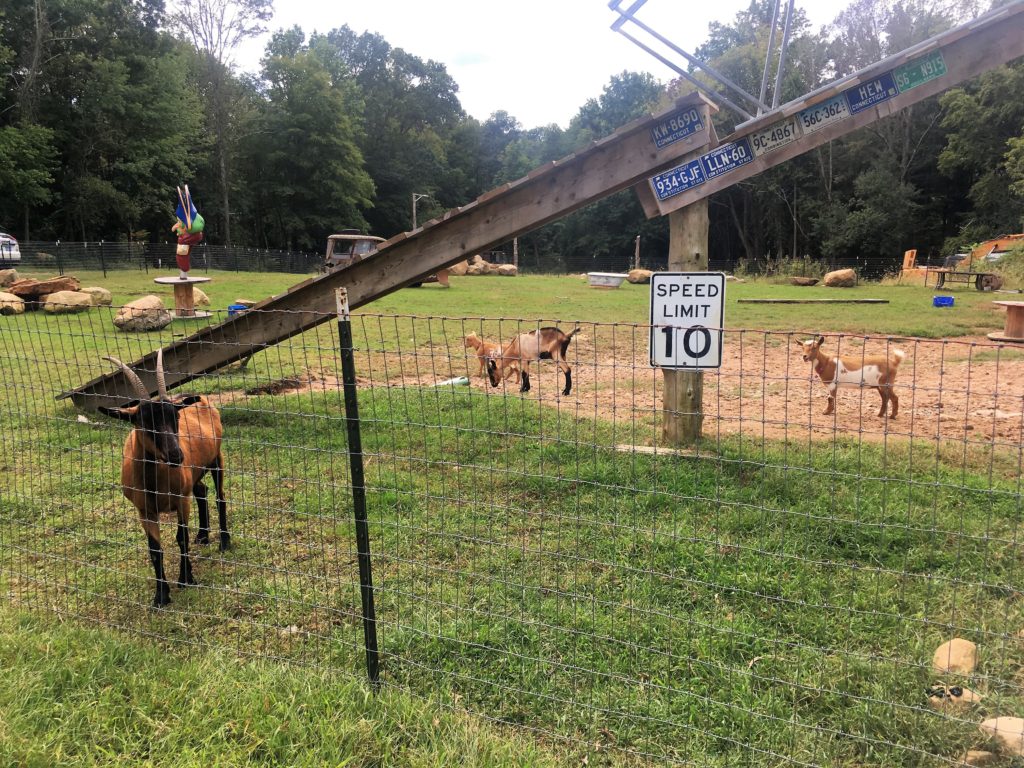
86 East Hampton Road, Marlborough, CT 06447 * https://www.goatsnroses.com
Rose’s Berry Farm
Rose’s Berry Farm is open for Sunday breakfast from June through October. Despite its short season, it may be the best Sunday breakfast experience you have. Everything served at Rose’s is farm fresh and farm-to-table, right from the farm it overlooks. Sitting high above the rows of berries and apples, you can enjoy waffles, pancakes, and french toast topped with seasonal fruit. Savory dishes are also available, but even if you are usually a fan of savory breakfasts as I am, this is one time to go the sweet route for the berries!
295 Matson Hill Road, South Glastonbury, CT 06073 * https://www.rosesberryfarm.com/breakfast
Where to Stay in Central Connecticut
Most accommodation options in central Connecticut consist of your typical chain hotels: Marriotts, Holiday Inns, Homewood Suites, etc. These are great choices if are only using your hotel as a place to sleep while you explore the area. However, if you want to try something a little more traditional Connecticut, check out the options below.
The Inn at Middletown
This property was built as a private residence in 1810, and subsequently acquired by the State of Connecticut to be used as an armory. In November 2003, the Town of Middletown opened the Inn as “an upscale full service boutique hotel.” If you are looking for charm and location within walking distance to many businesses and restaurants on Middletown’s Main Street, this is the place for you.

70 Main Street, Middletown, CT 06457 * https://www.innatmiddletown.com/ (Click here to book!)
Griswold Inn
Founded in 1776 during the American Revolution as a tavern and accommodation for shipbuilders who moved to town, the Griswold Inn has been in operation for more than 242 years. Its rich history follows that of America. You can experience what it was like to join fellow revolutionaries in the early years of the country in the tavern, or have a more upscale experience in the full dining room. The Griswold Inn also offers 33 unique bedrooms for rent: some have fireplaces, some provide a view of Main Street, and others overlook the water. If you want to step back in history on your visit to Connecticut, check out the Griswold Inn.

36 Main Street, Essex, CT 06426 * https://griswoldinn.com (Click here to book!)
*Note this page contains affiliate links. This means I may receive compensation for your use of these links, at no additional cost to you.

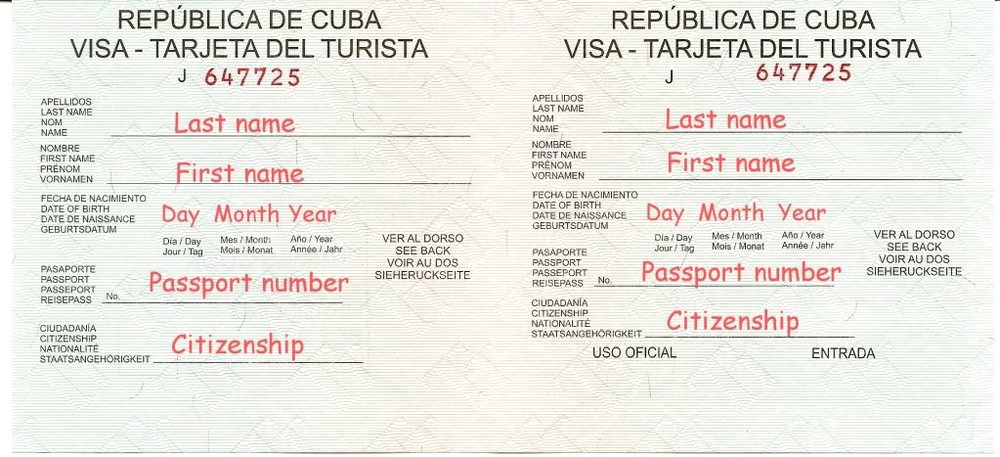
by Kelly | Apr 3, 2018 | Caribbean, Cuba, Travel, Travel Advice
(N.B. this post only addresses requirements for the “Support the Cuban People” visa, which is one of twelve visas available for Americans traveling to Cuba. While part of this post addresses legal requirements, nothing written here should be construed as legal advice.)
In 1960, the U.S. Treasury Department’s Office of Foreign Asset Controls (“OFAC”) placed an economic embargo on the country of Cuba. For practical purposes, this means Americans cannot travel to Cuba for tourism, and cannot spend money at any institution that is owned by the Cuban government or military. If you want to visit Cuba as an ordinary person (i.e. not on a volunteer/mission trip, not on an educational trip, and without close family on the island to visit), you must travel either with a group tour on the People-to-People visa, or plan your own trip with the Support the Cuban People visa. If you do not mind active vacations, the easiest option is to go on the Support the Cuban People visa.
Pre-Travel Requirements and Recommendations
Booking flights and accommodations
Flights
You can easily book a commercial flight to Havana from any major U.S. city, just like you would book a flight to any other foreign city. Five commercial carriers (American, JetBlue, Southwest, United, and Delta) offer direct flights to Havana from nine American cities (Miami, Fort Lauderdale, Orlando, Tampa, Houston, Charlotte, Atlanta, Newark, and NYC-JFK). If you are not departing from one of these airports you’ll have to book a connecting flight through one of them.
When booking your flight, you’ll be asked which visa you are traveling with. Select “Support for the Cuban People.” To enter Cuba, Americans are required to have temporary Cuban health insurance, since American health insurance won’t be available in Cuba. Most, if not all, commercial airlines include this in the price of your plane ticket. Check the enumerated fees and taxes when you purchase your ticket to ensure that the insurance is included. When in the country, your boarding pass to Cuba will be your first item of proof of health insurance if you need to use it.
Your airline will also offer you the opportunity to purchase your Cuban visa separately. The visa should cost between $85 and $100 per person depending on the airline. Also depending on the airline, you can purchase the visa online ahead of time, or at the airport from which your flight to Havana leaves: for example, if you are flying from Boston to Miami to Havana, you will need to purchase your visa in Miami, not Boston, if you are buying it at the airport.
Accommodations

AirBNB Room
To fulfill the Support for the Cuban People visa requirement, you must stay in a casa particular, which is like a bed and breakfast where the hosts live in the house in which you are staying, or select an AirBNB apartment. This is so that your money is going to a private individual, and so that you have hosts to interact with during your stay to learn more about the country from them. If no one in your party speaks fluent Spanish, make sure to book an accommodation where at least one host speaks some English. Also try to find a place that has a WiFi connection available, even if you have to pay for it. Public internet was only introduced to Cuba in 2011, and it is very difficult to come by when you are out and about. Most accommodations also do not yet have WiFi. Your host may charge you $1 or $2 per hour to use the WiFi, but at least you’ll know where and when it will be available.
Vaccines
The recommended CDC vaccines for Cuba are Hepatitis A and Typhoid. Typhoid is available as both an injection (lasting 2-3 years) and a live oral vaccine (lasting 5 years). The Hepatitis A vaccine is only offered as an injection (lasting 1 year for the first shot, 20 years with the booster shot, which may be taken after your trip). Note that you must receive the vaccines weeks before you will be exposed to the disease, so plan to receive these at least one month before traveling to Cuba if you choose to get them.
A word on the typhoid oral vaccine: while it seems beneficial to get a vaccine that will last 5 years, and to not have to get a shot, the oral vaccine is live and comes with very precise instructions. It consists of 4 pills that must be taken exactly 48 hours apart from each other. They also must be kept refrigerated at all times (in other words, don’t pick up the vaccine and then run errands before going home), not left in your mouth for more than a few seconds, and taken with very cold water to wash them down. It is also possible you will get sick and feel like you have a mild case of typhoid the day after taking each pill. This feeling may be progressively worse with each pill, leaving you feeling very sick the day after the last pill. After eight days you will probably feel totally fine and be vaccinated for years, but these side effects should be taken into account before opting for the oral vaccine.
As for Hepatitis A, you may think you are very careful with what you eat and drink, but there is really no way of knowing where or when you may be exposed to the disease. Hepatitis A is transmitted through the ingestion of fecal matter, which could happen if someone preparing food doesn’t wash their hands after using the bathroom. Considering the lack of soap and running water in the country outside of major cities (and sometimes in major cities) this probably happens often. While it is always a good idea to avoid raw food and ice while traveling in developing countries, it is also a good idea to be vaccinated against Hepatitis A in case you accidentally or intentionally let your guard down to try some of the local cuisine. I know multiple people who are careful, experienced travelers who were exposed to Hepatitis A in Cuba: those who were vaccinated had a wonderful, disease-free trip, while those who were not contracted the disease and had to live with it for weeks upon their return. Just something to consider.
Money
American credit, debit, and ATM cards will not work in Cuba because of the economic embargo. You will need to bring any money you may need with you in cash. In light of this, anything you can pay for by credit card online ahead of time should be done so (this includes your accommodations and probably some activities). After that, plan on bringing about $150 per day per person in cash. While this may seem excessive, it is better to have too much money and re-deposit it when you return to the U.S. than run out of money and not be able to pay for a taxi back to the airport.

There is mixed advice out there on whether it is necessary to convert USD to CAD or EUR before traveling to Cuba. Cuban money exchanges (“Cadecas”) will take USD, but a 10% fee is charged to convert money from USD to the Cuban CUCs because USD is otherwise useless on the island. The exchange rate is 1:1 for USD to CUC. Assuming the exchange rate of USD/CUC to EUR is 1.25:1, you have the following scenario: if you bring $1250 USD to Cuba, you will receive back 1,087.50 CUC (1,250 CUC minus the 10% USD transaction fee of 125 CUC, minus the standard 3% exchange fee of 37.5 CUC). If you first change your USD to EUR before leaving the U.S., you will exchange $1250 USD for 970 EUR (1000 EUR for the exchange rate minus the 3% transaction fee of 30 EUR), and then exchange 970 EUR for 1162 CUC (1198 CUC for the exchange rate minus the 3% transaction fee of 36 CUC). You see that by first exchanging your money to EUR you receive 75 CUC more for your $1250 USD, even with the double transaction fee.
When you are leaving Cuba, because the Cubans want to get rid of their USD, there is no 10% transaction fee, so you can just exchange all your CUCs back to USD minus the 3% transaction fee again. You may also run into airport workers such as janitors or security guards who are willing to convert your CUC to USD without the transaction fee. Usually these transactions are legitimate, though under the table from the government, but if you end up with a counterfeit bill you will have no recourse to reclaim your money.
Visa Requirement: Itinerary
To meet the requirements for the Support the Cuban People visa, you must maintain a “full-time schedule” of activities that “(i) enhance contact with the Cuban people, support civil society in Cuba, or promote the Cuban people’s independence from Cuban authorities; and (ii) result in meaningful interaction with individuals in Cuba.” Guidance on this requirement states that just staying in a private home, eating at private restaurants (paladares), and buying local goods from private vendors who approach you while you’re lying on the beach is insufficient; however, anything that involves actively engaging with locals that goes beyond this appears to be sufficient.
Full-time schedule is not defined in the law, so those looking to interpret this requirement have considered what it means to be a full-time laborer and a full-time student, and it is generally agreed that six hours per day constitutes a full-time schedule based on this analysis. You must participate in activities beyond residing in a private home and eating at private restaurants, but time spent interacting with locals at these places will count towards some of your six hours per day.
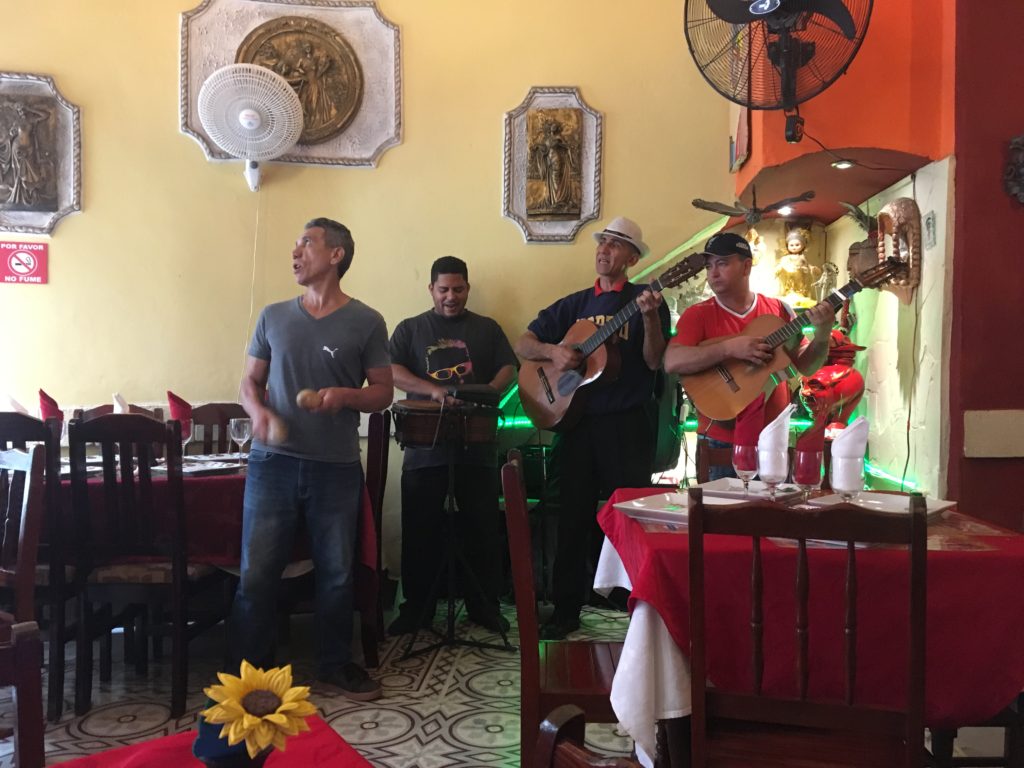
Musicians at a paladar restaurant, which clearly is also someone’s home.
It is recommended you set a full itinerary for yourself before traveling to ensure that you will meet the requirements. Visiting local museums and galleries, such as the Revolution Museum, Museum of Beautiful Arts, the Almacenes San Jose market, and Fusterlandia will count towards your itinerary, as well speaking with a local who gives you a tour of the city in his hot pink 1956 Chevrolet convertible. You may also book tours and activities via AirBNB experiences: anything listed here should count towards your full-time schedule as well. A day-trip away from Havana to see how Cubans live outside the city is highly recommended, as is a half-day bike tour around Havana. If you book tours online ahead of time you will not have to worry about spending your precious cash to pay for them in the country.
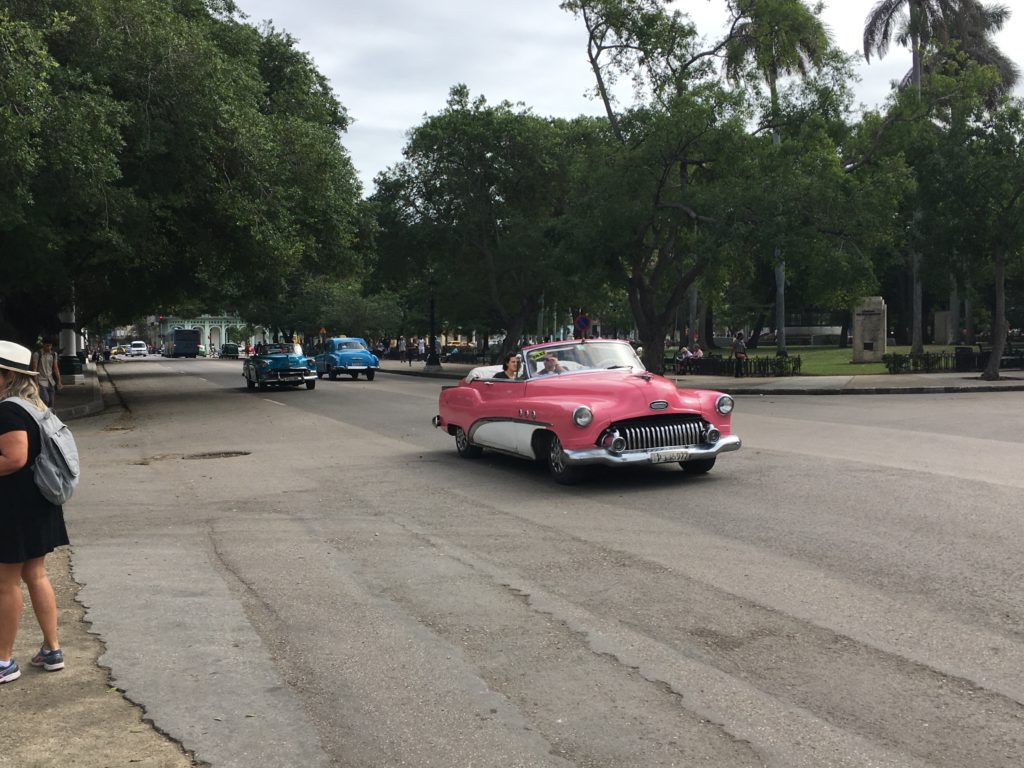
Tours in Old Cars

Visiting the Revolutionary Museum
You should research paladares to include in your itinerary before heading to Cuba, and try to make reservations at least for dinner for all of them ahead of time. Top recommendations include La Guarida, Locos por Cuba, El Del Frente, and La Cocina de Lilliam. For a nominal fee ($1 to $2), most reservations can be set up ahead of time using the website A La Mesa, the Cuban version of Open Table.
Arrival in Cuba
Money (again, it’s that important)
I cannot emphasize enough how you should just exchange all your foreign currency at the airport as soon as you arrive. The exchange rate will be exactly the same anywhere in Cuba, but doing this at the airport is quick and convenient, and you won’t have to interrupt your vacation for it again if you run out of CUCs later on. In one terminal there are ATM-looking machines that will complete the transaction for you. While there is mixed advice in this area, and in theory there are CADECA money exchange banks available in downtown Havana, the line to get into the bank can sometimes be over an hour long, and banks are often open at inconvenient times. The people in line and bank tellers will also only speak Spanish, so if you only speak English this transaction will be much more difficult than at the airport. You also need your passport with you to exchange money at the bank, and this is something you do not normally carry around with you in Cuba. Save yourself the time taken out of your vacation and just exchange all your foreign currency to CUCs at the airport (I certainly wish I had).
Getting Downtown
There are many normal yellow taxis waiting outside each terminal at Havana’s airport to bring people downtown. The price to get anywhere in Havana should be 25-30 CUCs. It is a set price: do not let yourself be talked into paying more unless you are considerably out of the way. To give you an idea, the ride to the intersection of San Lazaro and Calle Galiano from the airport was 25 CUC. Remember how much it cost to get downtown from the airport and don’t pay any more than that to return at the end of your trip either. This is a good rule of thumb for any taxi ride in Havana: if you only paid 15 CUC to travel from the Almacenes San Jose market to the Hotel Nacional, don’t then pay 20 CUC to return half the distance to your accommodation. Remember, you only have access to the cash you brought with you, so you are not being selfish by protecting it, you’re being smart!
Around Havana
Transportation
The easiest way to get around Havana is walking or by taxi, depending on how far you’re going. Taxis are plentiful around most tourist parts of the city and hotels, but be sure to negotiate or at least ask the price to a destination before accepting a ride! Most casa particular and AirBNB hosts will help you negotiate the price from your accommodation, since they know how much rides should cost.

Riding in the backseat of an old car
If you are brave enough to try local transportation, you may want to hop in a Taxi Colectivo! These cost about $1/person. They run set routes along major roads but will stop anywhere along the route to pick you up or let you off, just verify the general direction you’re heading before you get in. To flag a Taxi Colectivo down, stand on a main road and wave your finger up and down about waist height. These taxis seem to be safe, but be warned you may encounter some unique individuals riding in them….
Other available forms of transportation include rickshaws powered by bicycles and Coco Taxis, which are yellow, open-air motorized pieces of metal run by what appears to be a moped. There are no seat belts, they move rather slowly, and there is no protection from the elements if it starts to rain, but these can be a cheap way to get around short distances.
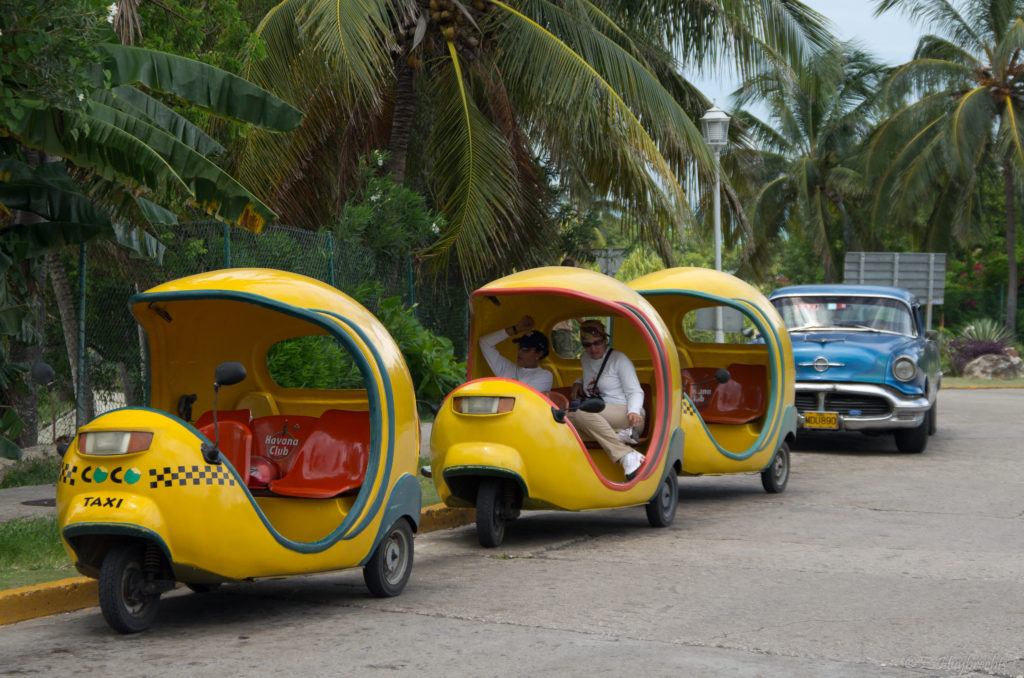
Coco Taxis
Regardless of how you intend to travel, you should download the maps.me app to your smartphone as well as the map of Cuba within the app before you leave the U.S. This app is minutely detailed and operates without WiFi. Even if your phone is on airplane mode it can locate you using satellites and provide walking or driving directions to any other location on your map. It is one of the most useful travel apps not just for Cuba but for any foreign destination.
Making Purchases
A requirement of the U.S. government regardless of which visa you travel to Cuba on is that you are forbidden from spending money at institutions that are government- or military-owned. A full list of these places can be found here. Aside from these entities, you can spend your money wherever you’d like!
If you intend to purchase cigars or alcohol, know that prices of these goods are controlled, so you will not find a better deal by shopping around. The easiest way to purchase cigars, alcohol, and coffee is at the airport right before you leave. There are shops available outside security if you’d like to place these items in your checked luggage (as would be required with bottles of liquid larger than 100 ml). Otherwise, feel free to and please do purchase souvenirs such as jewelry, paintings, and humidors from local vendors throughout the country as another way to support the Cuban people during your visit.
Safety
So long as you take precautions you would in any big city, Havana is totally safe. Because Castro’s government gave everyone a house when he came into power there are no homeless people. There are also strict laws against harassing foreigners as Cuba would like to build its tourism industry. Nevertheless, while I felt safe walking around even dark roads at night, I still wore a cross-body bag and kept my hand on my purse at all times, though this may have been unnecessary: I did not see or hear about any instances of theft or pick-pocketing. Generally if the Cubans are going to try and get money from you, they will do so openly.
A story of caution: on my first day in Havana, my dad and I arrived at the airport around 8am, and went through immigration, the health check (turning in a form that says you’re healthy) and customs without paying too much attention to the people we interacted with. Later that day walking down a very busy main tourist road in Havana, we were approached by a local who “just wanted to practice his English” and welcome us to his city. He asked where we were from and when we arrived. He also mentioned that if we wanted to buy cigars there was a huge monthly festival a few blocks away that was selling them for half-price from the factory workers. He then insisted he didn’t want anything and bid us good day.
A few minutes later as we were standing outside a restaurant contemplating lunch, a woman who spoke almost perfect English came up to us and said “the Americans! I saw you this morning, I’m an immigration officer! How are you liking Cuba so far?” At the time, my dad and I both thought the other person recognized her from the airport: in hindsight, she was clearly working with the guy up the road, who had gathered enough information for her to approach us. This interaction was followed up by the woman also mentioning the cigar festival and offering to take us there. Not realizing the two were working together at the time, the festival now seemed legitimate, as two separate locals knew about it. There was no festival: instead we were led down a somewhat deserted side street and into an apartment building where the exit was locked behind us. At that point, I gave us a 50/50 chance of being either robbed or killed. We were offered boxes of what I’m sure were fake cigars at “half price,” and were only allowed to leave when I insisted I had been asked to buy Romeo y Julietas by a friend (which was true), and these people did not have that type of cigar. After leaving the apartment, the woman insisted on showing us to a “fantastic” restaurant for lunch, and then requested $10 for her and her poor baby. We ended up giving her $5 and said that we couldn’t afford any more at the time since we were limited to the cash we brought with us and weren’t sure how much we would need, which was true.
In the end, we learned a $5 lesson when it could have been a $300+ lesson, and also got to include this encounter in our journals as an hour of”interacting with locals learning about the cigar industry.”
Returning to the U.S.
You will enter the U.S. and go through immigration and customs at the airport at which you land when you first return from Cuba. My experience going through immigration and customs was no different than returning from any other trip abroad. When asked what my purpose was for going to Cuba, I promptly said “to support the Cuban people” instead of “tourism,” and the officer smirked and let me go with no other questions. I’ve heard stories of Americans returning who have been asked by an immigration officer to produce their daily journal of activities (the itinerary or a bullet list should count), photos of all their receipts, and photos of the entire trip to prove the itinerary was followed, so you should be ready to produce those if necessary. You also must maintain all of these things for five years after you return in case you are audited by the Department of the Treasury. Note that even if you are not a U.S. Resident and you are just passing through the United States on a connecting flight back to your country, you will still need to meet one of the 12 U.S.-approved reasons for traveling to Cuba and possibly produce the proof listed above to a customs officer.
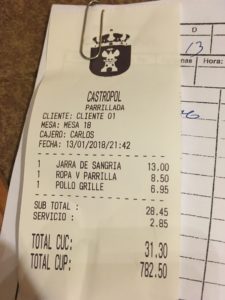
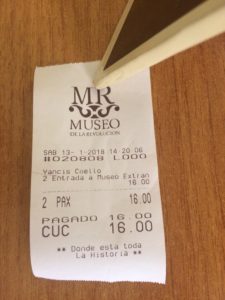
Photos of receipts for potential audits
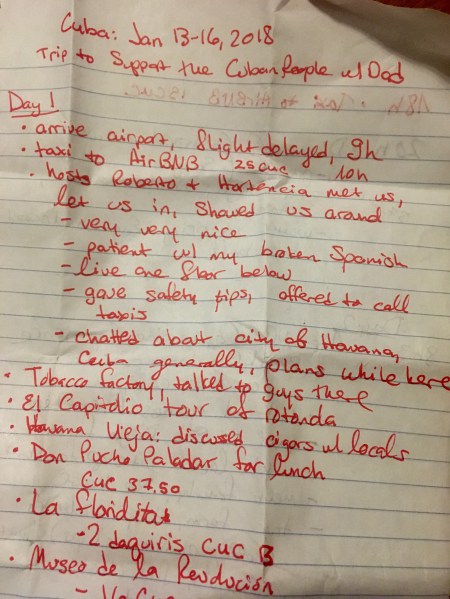
Example of “journal” kept in case of audit
For customs, U.S. Residents (citizens and legal permanent residents) over 18 or 21 are allowed to bring back (for personal use or gifts, but not resale) 1L of alcohol, 200 cigarettes, and 100 cigars. As with returning from any foreign country, U.S. Residents are limited to $800 total of goods brought back into the country for personal use and gifts. Therefore, even though you are allotted 100 cigars, if you purchase 100 Cohibas at $10 per cigar, you will exceed your $800 customs limit. To get around this you may split up items among your 18+ or 21+ family members and/or travel companions: e.g., if you want to bring back 100 Cohibas at $10 ($1000) and your wife wants to bring back 2L of rum ($20), you can each claim 50 Cohibas and 1L of rum for $510 each, which puts you under both the quantity and monetary personal customs limits.
In conclusion, it was considerably easier and cheaper to visit Cuba than I ever thought, so if you have any interest in seeing this beautiful country I would highly recommend it!
Love this post? Save it to Pinterest for later!
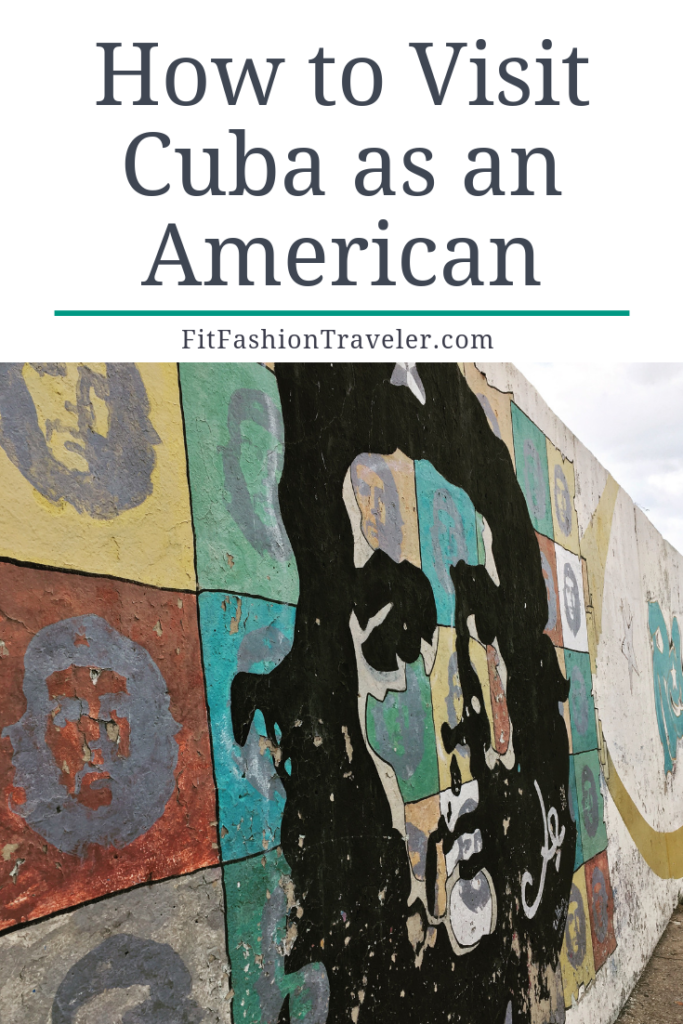

by Kelly | Nov 3, 2018 | Boston, Canada, Day Trips, Fit Travel, Maine, Montreal, North America, Travel, Travel Advice, United States, Vermont
New England ski resorts are open for 2018! For anyone looking to get away for a ski weekend in the Northeast from now until March or April, check out the resorts below. Each resort listed has great terrain, many accommodation options, villages offering you a break from your boots, and price points that won't break the bank, at least as far as ski weekends go.
Looking for more things to do in New England? Check out these posts about a Weekend in New Hampshire, Fall in Connecticut, and a Day Trip to Salem, MA!
Mount Snow
West Dover, Vermont * Opens for the season November 4, 2018 * https://www.mountsnow.com/

The Mountain
Mount Snow is the closest Green Mountain ski resort to both Boston (2.5 hours) and New York City (4 hours). It runs 20 lifts for its 600 acres of terrain, including the Bluebird Express that provides a front cover to cut the wind as you ride to the summit. The mountain provides mostly intermediate terrain, with a few steep diamond trails and a nice long, easy beginner trail down from the summit.

Two on-site accommodations are available at Mount Snow. The Grand Summit Resort Hotel provides ski-in ski-out privileges for the mountain. If you are looking for something more budget-friendly, stay at the Snow Lake Lodge across the street from the mountain, which is accessible by shuttle. Both locations offer hot tubs to enjoy during your après-ski time.
Village and Town
Mount Snow doesn't have a contained resort area, but it doesn't need one. The town of West Dover, Vermont, is a short drive away from the mountain and provides everything you would want in a ski town. If you want to be a part of mountain history, head for TC's Restaurant, home of Gold-Medal Olympian Snowboarder Kelly Clark. For something more upscale, sit in the dining room at West Dover Joe's. Looking for nightlife after dinner? The Snow Barn, a few feet from the mountain, provides drinks and live music most nights.
Overall Review: Given its location and size, Mount Snow is great for a short weekend ski trip or a long day of skiing if you're coming from New England or Eastern New York.
Killington
Killington, Vermont * Open NOW for the season! * https://www.killington.com/

The Mountain
Nicknamed "The Beast," Killington offers the biggest ski area in New England. Its size means there are enough trails to satisfy skiers of all levels. Thrilling black diamond trails challenge the best skiers, while beginners can stick to the numerous bunny trails or try a run from the summit entirely on beginner trails. Lift tickets are also some of the most expensive in the area at full price, but Killington often offers discount tickets if you spend time investigating.
The Killington Grand Resort Hotel at the base of the mountain is the perfect place to stay if you want all the comforts of a ski hotel. However, ski cabins are much more popular at Killington, as many of them have lift access, offering ski-on/ski-off capabilities. Killington's Managed Condos website or AirBNB can help you locate your ideal accommodation, whether it's a 12-person cabin with a private outdoor hot tub and indoor sauna, or a single-family two-bedroom bungalow.
Village and Town
Killington's Base Lodge offers numerous dining options for hungry skiers. Favorites include Preston's and Killington House of Pizza. If you want to venture into the cold for some nightlife, you must check out the Wobbly Barn, Killington's infamous music house and nightclub.
Overall Review: While Killington doesn't offer the on-site resort experience you may expect out West or in Europe, it has the best mountain in the area, so it's the best destination for serious skiers and their friends.
Jay Peak
Jay, Vermont * Opens for the season November 23, 2018 * https://jaypeakresort.com/
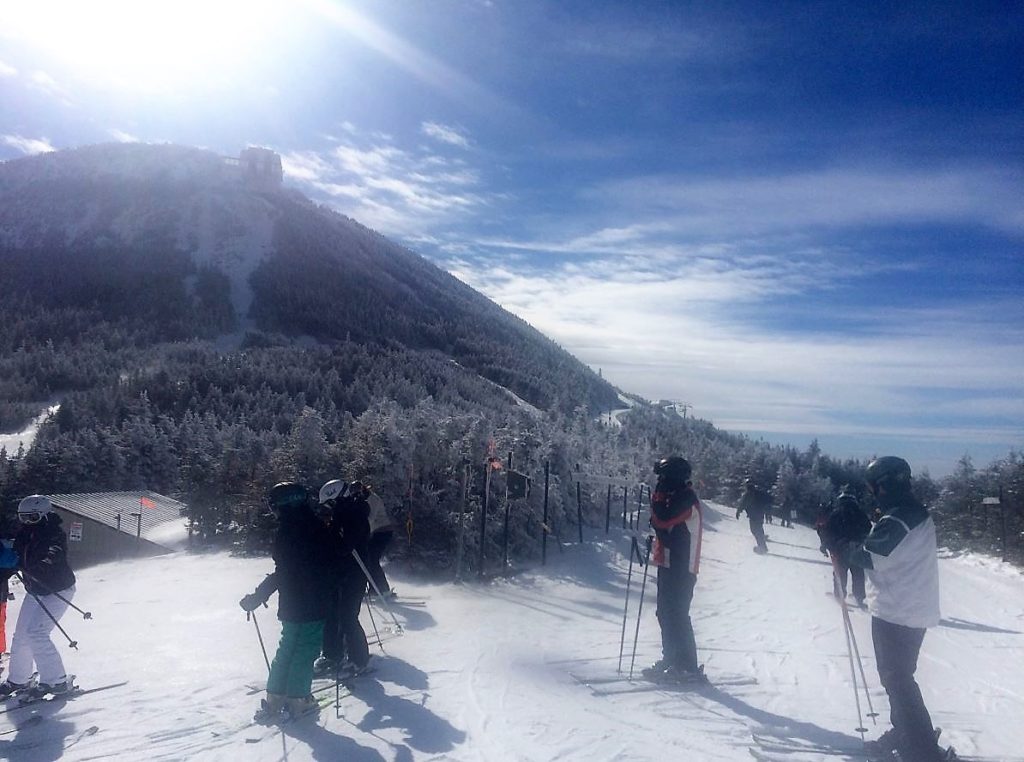
The Mountain
Jay Peak offers 385 acres of terrain with 79 trails. However, it boasts the encouragement of off piste skiing as well, with 100+ acres of glade terrain. Advanced skiers looking to challenge themselves can take advantage of this additional acreage, while advanced-beginner skiers will find the intermediate trails accessible.
Jay Peak offers numerous accommodation options, all connected with their convenient shuttle service. For a hotel-like experience, stay at the Hotel Jay, Tram Haus Lodge, or Stateside Hotel. Many condos and cabins are available for larger groups who prefer their own private residence.
Village
The New England ski resort with the most options available when you're ready to give the skis a break is Jay Peak. The Pump House indoor water park is a guest favorite with water slides, a lazy river, and indoor surfing. Access to the Pump House is included in your Ski and Stay ticket. The Ice Haus indoor ice skating rink lets you brush up on your other winter sport while you are on vacation. With 16 on-property restaurants, there is something to accommodate everyone's tastes at Jay Peak. At night, a few of the bars provide live music. If you want a quieter evening, see what's playing at the Movie Theater next to the Stateside Hotel.

Inside the Pump House
Overall Review: A large mountain near the Canadian border, Jay Peak offers a full day of skiing and plenty of dining and entertainment options off the mountain to keep you occupied for a long vacation.
Sugarloaf
Carrabassett Valley, Maine * Opens for the season November 19, 2018 * https://www.sugarloaf.com/

The Mountain
Sugarloaf is one of the most popular mountains in Maine. Though somewhat difficult to reach, traveling on about 30 minutes of dark, local roads after you pass Portland, the journey is worth it. Sugarloaf Mountain offers 162 trails, which are evenly divided among beginner, intermediate, and expert options. The signature feature at Sugarloaf is its summit lift that is the only lift to bring skiers to trails above the treeline in the East.
Sugarloaf Mountain is in the middle of nowhere, so you're going to want to stay on the mountain. The Sugarloaf Mountain Hotel offers beautiful rooms at the base of the mountain. If you don't want to stay in a hotel, your other option are the ski-in/ski-out condos and cabins on the mountain.
Village
Because of its remote location, Sugarloaf offers plenty to do on its property, and provides frequent shuttle buses to bring visitors to all its dining and entertainment options. The premium restaurant for a nice night out is 45 North. During the day, pick up a quick snack at Hunker Down or Alice & Lulu's between runs. If you're looking for a nice drink, The Widowmaker or Shipyard Brewhaus has got you covered. At night, take the shuttle to The Rack to grab a drink while listening to live music.
Overall Review: Sugarloaf's remote location mandates great customer service, a standard that the resort definitely lives up to.
BONUS REVIEW: Mont Tremblant
Mont Tremblant, Quebec, Canada * Opens for the season November 22, 2018 * https://www.tremblant.ca/

While this post is meant to focus on New England ski resorts, I would be remiss if I did not mention the absolutely best ski resort in the Northeast, just over the border in Canada. A 6-hour drive from Boston, or a quick flight from New York City, Mont Tremblant ski resort is absolutely worth the trip.
The Mountain
With 102 trails on four separate slopes, you could spend your entire trip covering new terrain with every run. The slopes are well-maintained with packed powder. Just remember to pack all your cold-weather ski gear: temperatures at the summit when I was there were below zero degrees Fahrenheit, without a wind chill!
There are cabins and condos available in the area of Mont Tremblant, but with such diverse options in the village, you should pick one of the official lodgings for your stay. The Fairmont and Le Westin provide the high-end, luxurious options. Homewood Suites and the Holiday Inn Express round out the hotel chain options with hotel suites including gas fireplaces and kitchens. For a more traditional experience, look into the Sommet des Neiges, Ermitage du Lac, and the Tour des Voyageurs.
Village
When you arrive at Mont Tremblant's village, you will think you've been transported to a European ski village in the French or Swiss Alps, and not just because everyone speaks both English and French. The village was built in 1939, creating Canada's first ski resort area. As you walk through the lower and upper villages, you will pass many shops, restaurants, bistros, and bars. Make sure to stop into a shop for your traditional Canadian maple taffy, freshly made on Mont Tremblant's snow!
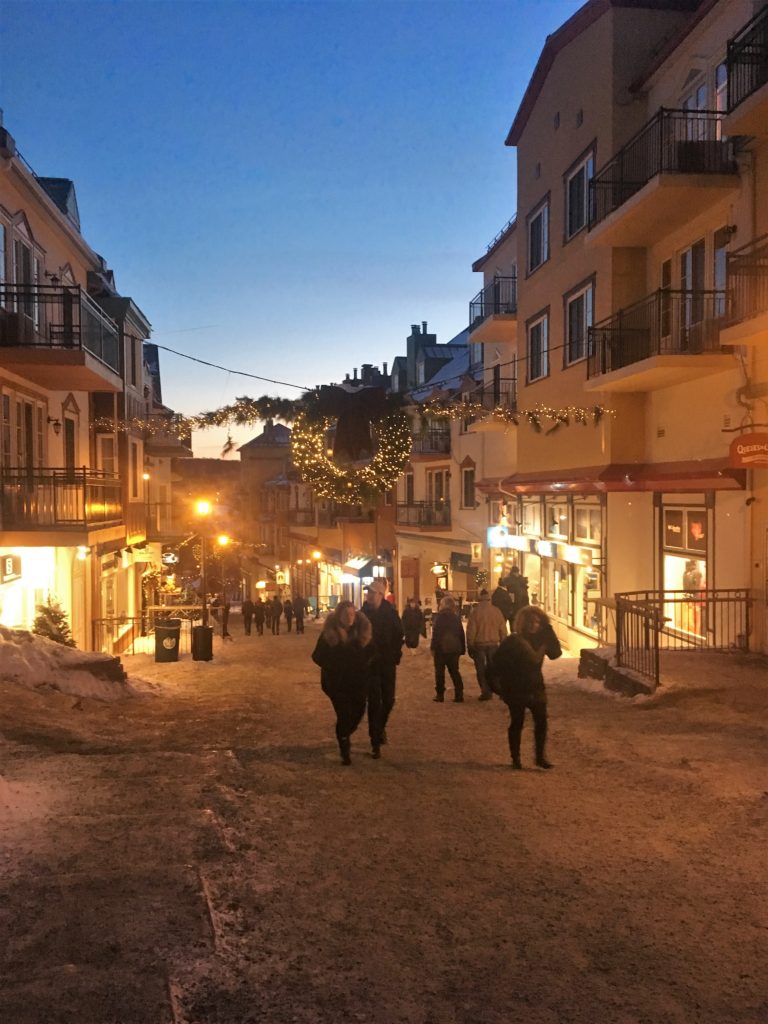
Overall Review: If you want a proper European ski resort experience, take the time to visit Mont Tremblant. Also worth noting for American visitors, this luxury ski resort is a bargain due to our favorable exchange rate! It is also advised to take advantage of American bank holidays to visit this Canadian destination: many Montrealers venture to Mont Tremblant on the weekends, but it is virtually deserted during the week. I had an entire trail to myself on Martin Luther King Day a couple years ago!
Ready to plan your ski weekend? Find some of my favorite ski gear, like goggles, helmets, jackets, and base layers here!
Love this post? Save it to Pinterest for later!
*Note: some of the links contained in this post are affiliate links. This means if you make a purchase through them I may receive some compensation, at no additional cost to you. As an Amazon Associate I earn from qualifying purchases.Thank you for supporting this page!

by Kelly | Jul 25, 2018 | Europe, London, Travel, United Kingdom
The original intent of this post was to highlight restaurants in London throughout the city. However, as I made my list of recommendations I realized that most of the restaurants were in the Notting Hill area, where I had lived in London. Therefore, this post will focus on restaurants just in the Royal Borough of Kensington and Chelsea. Next time you are in London, use the information below to head west and check out the best restaurants in London’s most exclusive neighborhoods!
Looking for more information about London? Check out the Getting to London post!
1. Julie’s

Julie’s restaurant is a hidden gem in Holland Park, an upscale neighborhood just past Notting Hill. The unassuming exterior on Portland Road opens to a variety of rooms, elegantly-decorated in a British-Egyptian style, creating many intimate spaces to enjoy your meal. Julie’s has been noted as a favorite special-occasion date spot of Princes William and Harry. Many other A-listers have been spotted walking through its doors as well. Prince Charles even began his bachelor party here before marrying Princess Diana! Even so, the menu and prices still are accessible to those of us commoners looking for fine dining in London, and reservations are not too difficult to come by.
135 Portland Road, Holland Park, London, W11 4LW * http://www.juliesrestaurant.com/
2. Electric Diner and Cinema

The Electric Diner is a casual restaurant connected to an old-fashioned cinema showing current movies (this week’s selection is Mama Mia! 2). You can grab a drink or a bite to eat at the diner before catching a show in one of the leather armchairs, couches, or front row beds featured in the theatre next door. One of the best features, especially for Americans, is the brunch served every Sunday! Among other offerings, the diner features many popular brunch items, including a proper Bloody Mary, which is surprisingly hard to find at restaurants in London.
191 Portobello Road, Notting Hill, London, W11 2ED * http://www.electricdiner.com/
3. Beach Blanket Babylon

Beach Blanket Babylon has some of the best pre- or post-dinner cocktails in the area. Its decorations are also incredibly ornate with Roman and Greek design influences. I unfortunately cannot speak to the food, but be sure to try the Elderflower Daiquiri if you go for cocktails, you won’t be disappointed.
45 Ledbury Road, Notting Hill, London, W11 2AA * https://www.beachblanket.co.uk/
4. Granger and Co.

Granger and Co. is a lovely casual upscale restaurant in the heart of Notting Hill. Its large windows let in vast amounts of light during the day, which make it an inviting space to either chill out at the bar with a pastry or grab lunch with friends. The light lunch menu reflects the high-end air of the area without the high-end price points.
175 Westbourne Grove, Notting Hill, London, W11 2SB * https://grangerandco.com/
5. Harrod’s Champagne Bar


Outside the Notting Hill area in Knightsbridge, Harrod’s is famous for its luxurious shopping experience. This Qatari-owned shopping mecca, offering everything from Alexander McQueen ball gowns to gustatory delicacies to throw pillows, also features 23 dining options. Though you may not think of a shopping emporium as hosting some of the best restaurants in London, you should give it a chance: the Champagne Bar in particular does not disappoint. Do not make the mistake of thinking you should skip this option due to its high price-points. Like most things in life, the price is worth it for a once-in-a-lifetime experience.
87 Brompton Road, Knightsbridge, London SW1X 7XL * https://www.harrods.com/en-gb/restaurants/fine-dining/the-champagne-bar
6. The Real Greek
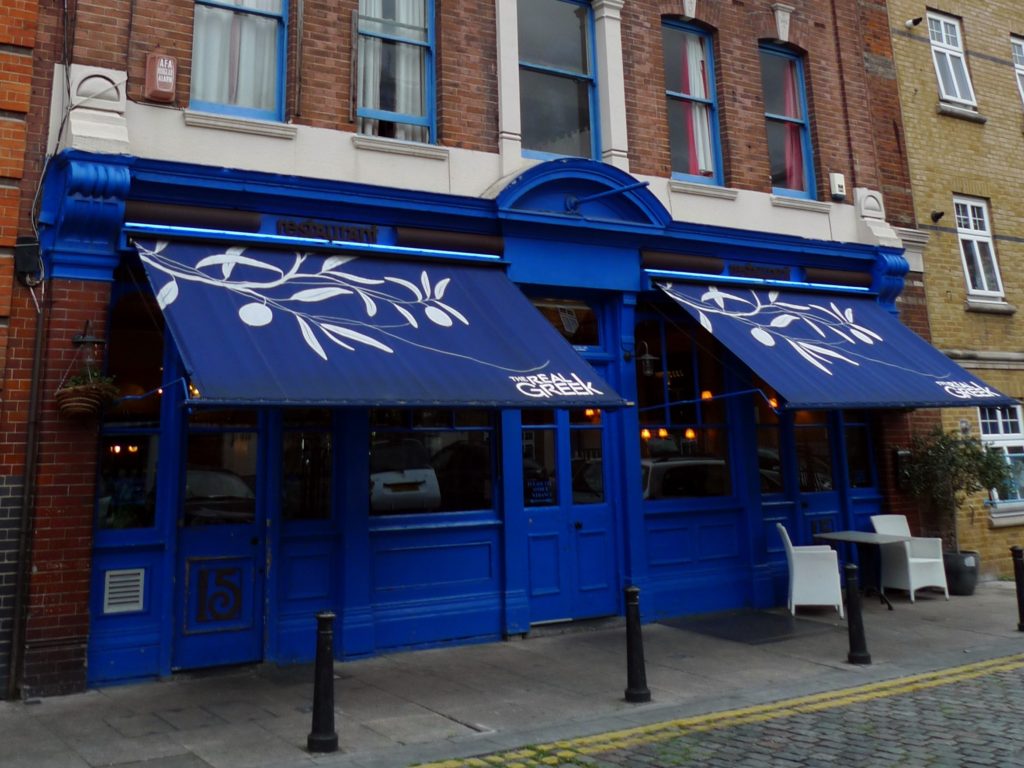
This restaurant has ten locations in London, including a location just outside Kensington and Chelsea in Shepherd’s Bush. I became obsessed with finding authentic Greek food when I visited Greece two years ago, but long before this I became obsessed with London’s restaurant The Real Greek. Featuring a variety of hot and cold small plates, The Real Greek is a fun place to dine out with friends while also a welcoming environment when dining alone: I can personally speak to both experiences! With so many locations you cannot fail to run into this restaurant, so be sure to stop in when you see one.
Southern Terrace, Westfield Shopping Centre, 1073 Ariel Way, Shepherd’s Bush, London W12 7GB * http://www.therealgreek.com/
Bonus! Borough Market
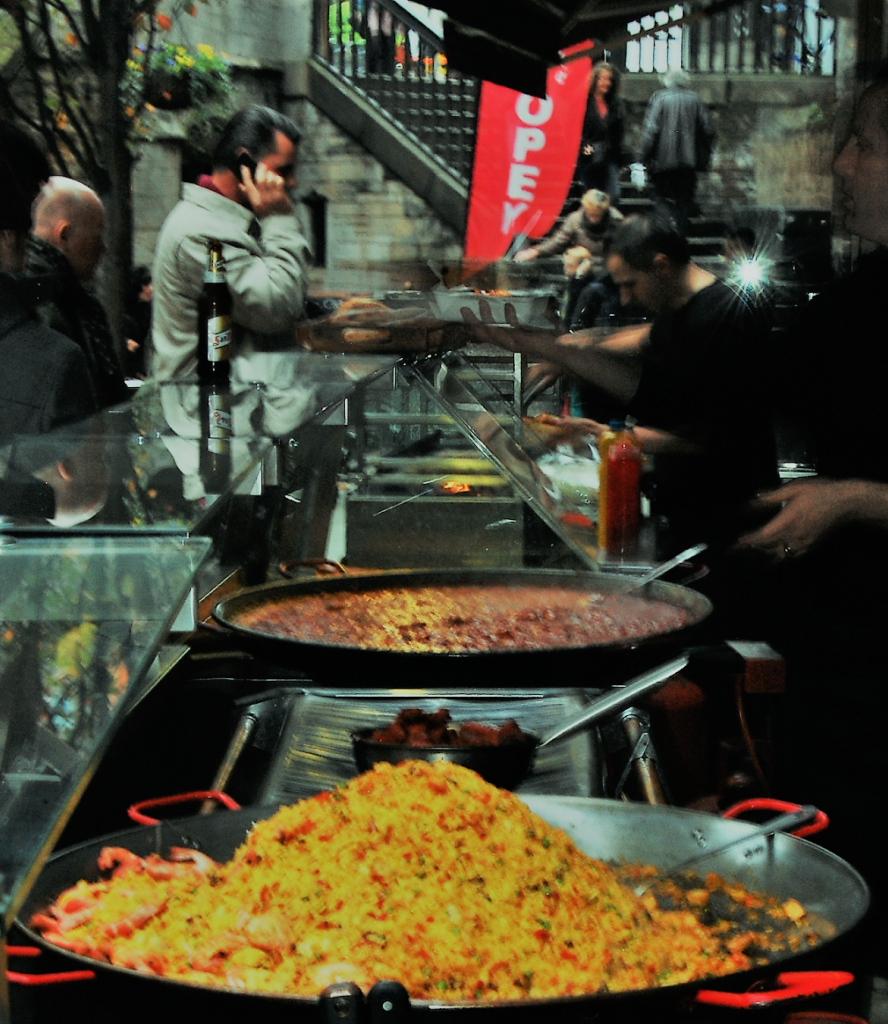
Borough Market is an outdoor food market on the opposite side of London from Notting Hill. Regardless, it is my favorite lunch spot in the city. It is fun to walk around and see the unique specialty items offered from around the world. It also allows a group of picky eaters to each select a different cuisine and still all dine together. Best of all, you can pick up a pitcher of sangria or Pimm’s cup to enjoy along with your selection!
8 Southwark Street, Southwark, London SE1 1TL * http://boroughmarket.org.uk/
Love this post? Save it on Pinterest for later!
